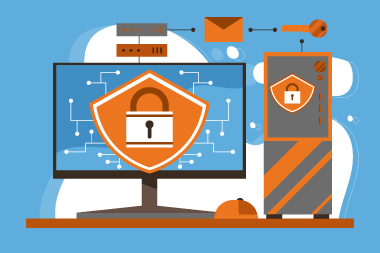8 important things to consider when selecting your VDI thin client management software
If you have more than 10 thin clients, you cannot manage them manually one by one. Therefore, the central management tool that is usually provided alongside your thin client solution is crucial. It is indeed absolutely needed to automate management tasks such as device deployment, software upgrade, classification, definition of specific settings, troubleshooting, and more… The main objectives of a thin client management software are to:
- Help provide a perfectly configured thin client endpoint to the user,
- Make the daily IT workload lighter,
- Allow secure administration from anywhere.
So what are the most important factors to consider when selecting a thin client management software? Below are some key elements to focus on, to bring you closer to a Zero configuration and low maintenance thin client experience.
1. A smooth installation process
The magic of beginnings
Pay attention to the installation process of the management console, especially the backend part. How demanding are the prerequisites? is there multi-tenancy? is it cloud-based or On-premise? Although you won’t have to worry about it once it is installed, you may still want to check if the installation requirements match your needs. The following elements can give you a good idea of how easy the installation and maintenance of this management software will be.
- Do you need a specific platform to store the backend? Or can you simply install the management console on a regular Windows virtual Machine?
- How much storage is required?
- Is the solution Multi-tenancy?
- Can it be stored in the cloud if needed?
2. Security
You can never be too careful

Today, security is a major concern for everyone, and threats can come from anywhere, including from the endpoint. Controlling what is happening on the endpoint side is an absolute requirement. Some thin client software vendors take security very seriously and include the following features in their management software:
- No local configuration tool allowed
- Certificate management on the management software, including Java, with access to key store
- VPN enablement for remote connection
- Secure management of remote devices, thanks to a dedicated gateway component
- Accountability of admin actions: what admin did what action on what terminal?
- Several levels of administration rights based on the admin profile
3. Basic actions
If these are not there, it’s a no go
Below are the features you will absolutely need on a daily basis to manage your thin client fleet. Verifying this checklist from the start will help you to sort through the various solutions you intend to test, before diving into further details.
- Visualization of all devices at a glance
- Group management and classification of devices
- Automatic registration of new devices
- Templates can be easily applied on devices or group of devices and offer granular configuration options
- Efficient and secure troubleshooting options
- Gateway to manage remote devices securely
- Both Zero and Thin client modes are available via one single software
4. Licensing aspect
Your CFO will thank you.
Carefully assess your costs when considering a new thin client vendor, especially when it comes to side services such as the management console of course, but also technical assistance, software maintenance, licensing, add-ons components…You may have bad surprises when you want to buy the full solution, and not only the thin client device or OS itself. Some of the elements below are key indicators that you are looking at a fair and TCO effective solution.

- Is the management tool complimentary when purchasing thin client licenses?
- Does the management tool include all features or are certain features considered upgrades?
- Is it a concurrent licensing model, with license not tied to a specific user or MAC address?
- Is there a fee for version updates?
- Is there a fee for support?
5. Reporting and information
Forewarned is forearmed.
Managing thin clients in an efficient way requires to be fully informed about user activity, last updates, troubleshooting actions, etc. If your thin client management console provides you with the right information at the right time, it can save you a lot of time and trouble. Below are some examples:
- Monitoring and visibility of device data, and informational dashboards
- Integration with third-party applications via rest API, enabling communication with other tools such as inventory tool to keep track of device count for example
- Accountability of admin actions: what admin did what action on what terminal
6. Web-based console
You can’t say it enough: the future of the workspace is (also) in the cloud!
Working and managing workers remotely has become imperative in the past years. Shifting to cloud-based tools is a massive trend, and thin client management is no exception. Even if an On-Premise tool can be justified in many cases, you may want to consider how “cloud-compatible” your thin client solution is. For example, interesting features can be:
- Ability to manage devices remotely even when out of LAN
- Support of public clouds such as Azure or AWS
7. Integration with third party virtualization platforms, hardware, and applications
Ensure that everything you need is accessible

Even more than a PC, a thin client depends on the infrastructure it belongs to access data. The endpoint is the entry gate to the company’s environment, but also to the outside world. one should ensure that the thin client supports all the hardware that users will need on a daily basis. All of this, of course, being manageable through the management software. Below are some examples of compatibility use cases that should be paid attention to:
- Support of repurposed devices in a seamless way
- Connected monitor information (resolution, size…)
- Configuration options available per vendor and access protocol (RDP, Nutanix Frame, VMware Horizon, Citrix)
- Ability to manage some settings for videoconference tools such as Teams, Zoom
- Possibility to add an MFA solution
- Rest APIs to connect to Inventory solution for example
- Regular client updates based on release calendars of vendors such as Citrix and VMware
8. Some actions have to remain available for users for local configuration
Because you can share the workload with your users, but only a little bit
It is good that the admin has control over as many elements as possible, yet the user has to be able to configure some parameters alone, based on his/her comfort level and preferences, without compromising on security.
- Possibility for the user to configure Wifi, date, language, display options such as screen luminosity, etc.
- However, no sensitive data available on the user’s side
A good thin client / zero client management software can be a game changer for IT teams. The daily workload can be dramatically reduced with the right features and information.
This article serves as a summary based on years of experience dealing with thin client and cloud users. This is why, of course, we’ve ensured that our own thin client management tool ZeeConf addresses these points.
We strongly recommend you to check the ZeeConf Thin Client / Zero Client management console features shown in these short videos.
To learn more about ZeeConf, you can also schedule a demo with one of our experts.
The proof is in the pudding!
30 minutes is all you need to get to know ZeeConf. Start by repurposing your own PCs using ZeeTransformer. We offer 10 free licenses that are yours to keep; a great way to get to know the solution!
Related Posts
Search
Recent posts
- The main Cybersecurity risks of remote work: Safeguarding your infrastructure in a connected world 3 April 2024
- Introducing the latest version of ZeeScan! 22 February 2024
- Chromebooks in Business: Advantages and Challenges to Consider 19 February 2024
- Happy New Year from all of us at ZeeTim! 1 January 2024
- ZeeTim’s 2023 recap: Elevating end-user computing excellence 26 December 2023





